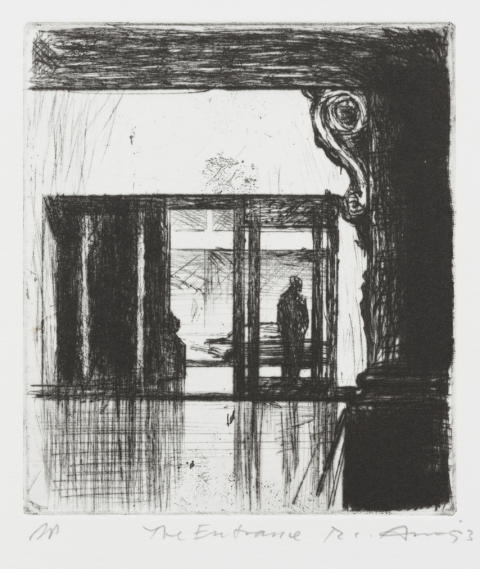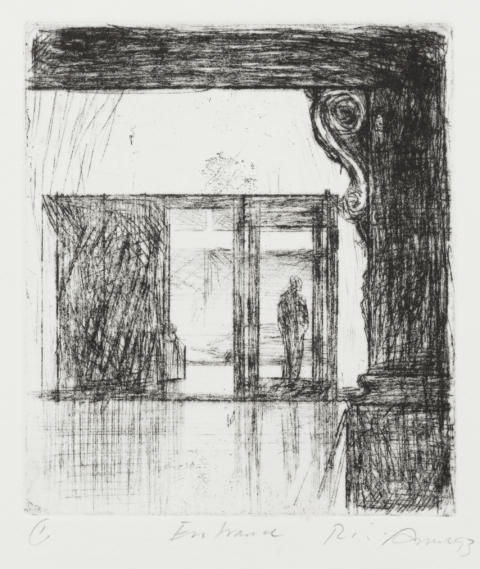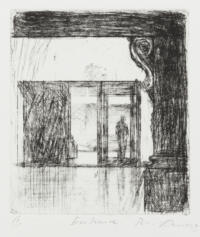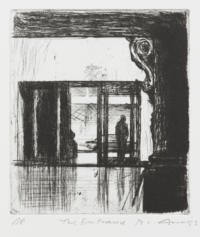
Drypoint. A view from a large anteroom, through glass doors and onto a street. Framing the scene on the right is a column with a scroll capital, on a pedestal, and along the top is what looks like a beam. A man, silhouetted against the light, can be seen through the glass door at right, and on the opposite side of the roadway is a car. The subject is lightly scored in drypoint.
The rocker tone has been extended down to cover the entire base of the column at right. There are two variant impressions of this state.
- Catalogue Number
- E.083
- Title and Date
- Entrance 1993
- Description of Featured Image
- A view from a large anteroom, through glass doors and onto a street. Framing the scene on the right is a column with a scroll capital, on a pedestal, and along the top is what looks like a dark beam. A man, silhouetted against the light, can be seen through the glass door at right, and on the opposite side of the roadway is a car.
- Where Made
- Dunmoochin, Cottles Bridge
- Medium Category and Technique
- Intaglio Print: Drypoint, burnishing and rocker on copper
- Support
- Wove paper. Identified papers: No papers identified.
- Dimensions
-
Image size: 143 x 129 mm
Matrix size: 146 x 130 mm - Artist’s Record Number
- RAE.79
- Printer(s) and Workshop(s)
- All impressions printed by Rick Amor in his Dunmoochin studio, Cottles Bridge.
- Summary Edition Information
- Four states. No edition.
- Exhibitions
- Niagara Galleries at IWOP 1997: Niagara Galleries at the International Works on Paper Fair, Mitchell Galleries, State Library of New South Wales, Sydney, 17–20 July 1997, no. 15 (as edition of 10).
- Literature
- For an illustration of the painting Study for ‘The ante-room’, 1993, see Gavin Fry, Rick Amor, Beagle Press, Roseville, NSW, 2008, p. 55.
- Collections
- State Library of Victoria, Melbourne: four state impressions, numbered 1 through 4; AP II.
- Comment
The setting here is based on the interior depicted in the painting Study for ‘The ante-room’, 1993 (Fry 2008), which, in turn, derives from a photograph that Amor took of the interior of 333 Collins Street, Melbourne. The artist has referred to this former bank, built in the 1890s and subsequently radically remodelled, as ‘a wonderful building’. A feature of its grand domed chamber are original clusters of columns topped with scrolls; there is one such column at the left in Amor’s painting, and one on the right in the present print.
In making this drypoint, Amor cut down the composition of his painting. He contracted the space, bringing the entire subject closer to the foreground. In addition, the column no longer appears in the round, as it does in the painting, and here is used chiefly as a framing device, focusing attention on the solitary figure in the doorway.
Conveying a sense of the distance between the framing device and the view beyond it required careful tonal adjustment. In the third state of E.083, Amor worked with a rocker in order to intensify the dark tones along the right edge of the image, and thus to articulate the space more clearly. More depth of tone was needed in the fourth state, and so the use of the rocker was extended. Despite this tonal calibration, however, Amor decided not to print an edition of the work.
- Keywords
- Building interior, Solitary male
- URL
- https://catalogue.rickamor.com.au/works/intaglio/entrance/
Record last updated 15/02/2021


